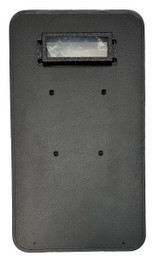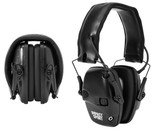Guide To Ballistic Shields: Design And Features - Battle Steel®️
Guide To Ballistic Shields: Design And Features
The ballistic shield is a crucial piece of equipment for any law enforcement or military officer. To help you select the product that best suits your needs, we have written a guide to the design and features of ballistic shields, assessing their weight, size, shape, material, and more.
Weight
20 years ago, the majority of ballistic shields available were of a basic design – rectangular with a flat face. These shields successfully stopped bullets in their tracks and protected the bearer from harm, but had the downside of being very heavy and cumbersome to carry for a long period of time. This negatively impacted the shield-bearer’s safety, as it slowed their movement and speed in emergency situations. Because of their unwieldiness, some law enforcement and military departments preferred to use other forms of ballistic armor instead of shields.
Since then, innovations in material technology have greatly decreased the weight of ballistic shields. Lightweight shields give personnel a high level of mobility as well as optimum ballistic protection. For example, Level III shields now weigh just 14 lbs. (6 kg) as opposed to 50 lbs. (23 kgs) 10 years ago – that’s a weight reduction of nearly four times while retaining the same protective capabilities. The introduction of advanced materials (such as composites, ceramics, Ultra-High Molecular Weight Polyethylene, and Kevlar) once again makes shields a fantastic protective option, and provides law enforcement and military departments with the equipment that they really need for safe dynamic operations.
Size
Ballistic shields come in different sizes. At the smaller end of the spectrum, ballistic shields measure 16 x 20 inches (41 x 53 cm) and are intended to protect just the torso and head. These small shields are highly maneuverable and easy to store and rapidly deploy – an ideal armor for police to keep in their patrol vehicles and utilize for forming perimeters or entering moderately dangerous situations. Due to their small size, such shields are best used when there are other protective barriers in the vicinity e.g., walls, trees, or vehicles.
Most shields measure between 20 x 30 inches (51 x 76 cm) and 24 x 36 inches (61 x 91 cm). These medium-sized shields have a larger surface area and therefore offer a greater level of protection, yet can still be carried fairly easily. Next, we have larger shields – 24 x 48 inches (61 x 122 cm) – which provide fuller body protection for running or crouching personnel.
At the large end of the spectrum is the biggest available ballistic armor – rolling shield systems (also known as wheeled trolley shields) composed of a shield mounted on a moveable frame. These are typically used at security or border checkpoints, schools, and embassies. They provide the maximum surface area and level of protection in dangerous situations, and can shield multiple personnel simultaneously. The downside is their heaviness (100+ lbs.) and decreased maneuverability – rolling shield systems take time (and multiple people) to assemble and move, making them unsuitable for highly dynamic situations.
Shape
Ballistic shields come in several shapes that are best suited for use in different tactical operations.
- Rectangular shield: this is the most basic shape of ballistic shield.
- Flat shield: these are the cheapest shields to produce. When used in conjunction with other flat, rectangular shields, they can build an impenetrable wall of defense – just picture the testudo ‘tortoise’ formation used by Ancient Roman legions.
- Curved shield: these provide better wraparound protection for the bearer, are more comfortable to carry, and dissipate a bullet’s kinetic energy more effectively.
- V-shape shield: these have a wider area of protection at the top, protecting the head and vital organs, and taper to a point at the bottom of the shield. They are intended for linear assaults.
- Dynamic shield: these shields are mounted onto frames and trolleys and are rectangular in shape, made up of a single or several panels. As they are self-supporting, the personnel concealed behind them can easily use their weapons.
Material
The materials used to fabricate a shield are engineered to stop specific ballistic threats. Ballistic shields are rated according to the NIJ’s Threat Protection Levels IIA – IV. Level IIA is the lightest and most maneuverable armor, and Level IV is the heaviest but most protective shield available.
- Soft armor: shields and tactical blankets made of soft materials (Level IIA, II, IIIA) are lighter than hard armor and can easily be rolled up and stored in a vehicle. They are ideal for use by emergency medical services or civilians.
- Hard armor: hard shields (Level IIIA, III, IV) provide a higher level of protection than soft ballistic armor. They are heavier, but you can still find surprisingly light shields. These are most suitable for police and military tactical use.
Viewport
A viewport is the clear window embedded in the shield that enables the bearer to see behind their armor. This is a key tactical advantage which increases the officer’s awareness of their surroundings, and therefore their safety.
The size of the viewport varies based on the type of shield and its intended deployment. They are typically found on larger shields. Sometimes, only a narrow horizontal viewport is necessary to allow the officer to scan their surroundings laterally. In other cases, you can find newer shields with larger viewports that offer a wide scope in all directions.
Any gap in the shield’s surface could be a point of weakness, and if the viewport is scratched or damaged this limits the bearer’s visibility. Viewports must be incredibly durable and bullet resistant and are typically manufactured from materials such as polycarbonate.
Color and finish
Previously, ballistic shields were mostly available in black – but now, you can purchase them in a range of colors that blend into all kinds of situations: tan, brown, green, multi-camouflage green, multi-camouflage black, and more. Some ballistic shields are finished with specially-engineered NIR reflective pigments, that prevent night vision goggles from spotting the shield and its operator. As well as standard ballistic shields, some manufacturers produce transparent shields made from polycarbonate laminate (a similar material to shield viewports). These offer maximum visibility to the bearer – not only for identifying threats straight ahead, but also for avoiding trip hazards.
Handle
In years past, shield handles used to be basic plastic or metal contraptions. In today’s armor market, they are fabricated from the same advanced materials as the shield itself – composite, aluminum, or polycarbonate – and have ergonomic and streamlined designs. This is for a good reason – the handle is one of a shield’s most vital features and impacts how well the personnel can operate their shield and their weapon.
There are several handle options available on ballistic shields:
- Assault
- Horizontal handle
- Tri Grip
- Tri Grip Emergency Response Team: a cross between Horizontal and Tri-Grip
- Adjustable Grab handle featuring a forearm strap
Each law enforcement or military department has its own standard operating procedure for carrying, so it is important to choose a shield which accommodates this. The majority of ballistic shields have a two or three position handle system, enabling single or double-handed operation. Ambidextrous handles allow a shield to be shared by left and right-handed officers. For added comfort and reduced injuries, ergonomic features such as high-density forearm pads can be attached to the shield handle.
Recent Posts
-
Understanding Ballistic Shield Ratings and Their Applications
The Trusted Name in Tactical Defense - BattleSteel® When it comes to protecting those who protect us …2025-04-19 -
The Importance of Hearing Protection in Tactical Environments
The Legacy of BattleSteel® BattleSteel® is a trusted name in the world of tactical defense equipment …2025-04-14 -
How to Properly Fit and Wear a Plate Carrier
About BattleSteel and Their Mission BattleSteel is a trusted name in the tactical gear industry, ren …2025-04-11


